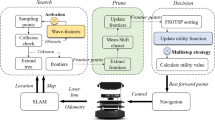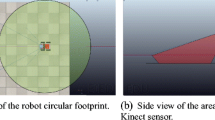Abstract
In this study, the goal is to efficiently and actively search for a target object in a previously unknown large-scale environment. To this end, we develop a probabilistic environment model that can utilize spatial commonsense knowledge and environment-specific spatial relations. The model evaluates the merit of exploring each possible viewpoint in the environment to find the target object. Then, the path planning method incorporates the estimated value of these viewpoints and the time cost between them to generate an efficient search path that minimizes the total search time. We also describe a search space reduction method that improves the feasibility of the proposed approach in large-scale environments. To validate the approach, we compare the search times of the proposed method to those of human participants, a coverage-based search and a random search in simulation experiments. The results show that the proposed method can generate search paths with similar search times to those of human participants, while clearly outperforming the coverage-based and random search methods. We also demonstrate the applicability of the approach in real-world experiments in which the robot could find the target object without a single failure case in 70 trials.






Similar content being viewed by others
References
Suh IH, Lim GH, Hwang W, Suh H, Choi JH, Park YT (2007) Ontology-based multi-layered robot knowledge framework (OMRKF) for robot intelligence. In: 2007 IEEE/RSJ international conference on intelligent robots and systems (IROS), pp 429–436
Lim GH, Suh IH (2012) Improvisational goal-oriented action recommendation under incomplete knowledge base. In: 2012 IEEE international conference on robotics and automation (ICRA), pp 896–903
Shubina K, Tsotsos JK (2010) Visual search for an object in a 3D environment using a mobile robot. Comput Vis Image Underst 114(5):535
Ma J, Chung TH, Burdick J (2011) A probabilistic framework for object search with 6-DOF pose estimation. Int J Robot Res 30(10):1209
Kollar T, Roy N (2009) Utilizing object-object and object-scene context when planning to find things. In: 2009 IEEE international conference on robotics and automation (ICRA), pp 2168–2173
Samadi M, Kollar T, Veloso M (2012) Using the web to interactively learn to find objects. In: Twenty-Sixth AAAI conference on artificial intelligence, pp 2074–2080
Kunze L, Burbridge C, Hawes N (2014) Bootstrapping probabilistic models of qualitative spatial relations for active visual object search. In: 2014 AAAI spring symposium series, pp 24–26
Kunze L, Doreswamy KK, Hawes N (2014) Using qualitative spatial relations for indirect object search. In: 2014 IEEE international conference on robotics and automation (ICRA), pp 163–168
Zhang S, Stone P (2015) CORPP: Commonsense reasoning and probabilistic planning, as applied to dialog with a mobile robot. In: Twenty-Ninth AAAI conference on artificial intelligence, pp 1394–1400
Zhang S, Sridharan M, Wyatt JL (2015) Mixed logical inference and probabilistic planning for robots in unreliable worlds. IEEE Trans Robot 31(3):699
Veiga TS, Miraldo P, Ventura R, Lima PU (2016) Efficient object search for mobile robots in dynamic environments: semantic map as an input for the decision maker. In: 2016 IEEE/RSJ international conference on intelligent robots and systems (IROS), pp 2745–2750
Toris R, Chernova S (2017) Temporal persistence modeling for object search. In: 2017 IEEE international conference on robotics and automation (ICRA), pp 3215–3222
Kunze L, Sridharan M, Dimitrakakis C, Wyatt J (2017) Adaptive sampling-based view planning under time constraints. In: 2017 European conference on mobile robots (ECMR), pp 1–6
Zhu Y, Mottaghi R, Kolve E, Lim JJ, Gupta A, Fei-Fei L, Farhadi A (2017) Target-driven visual navigation in indoor scenes using deep reinforcement learning. In: 2017 IEEE international conference on robotics and automation (ICRA), pp 3357–3364
Hanheide M, Göbelbecker M, Horn GS, Pronobis A, Sjöö K, Aydemir A, Jensfelt P, Gretton C, Dearden R, Janicek M et al (2017) Robot task planning and explanation in open and uncertain worlds. Artif Intell 247:119
Dougherty ER, Lotufo RA (2003) Hands-on morphological image processing, vol 59. SPIE Press, Bellingham
Vogt P, Riitters KH, Estreguil C, Kozak J, Wade TG, Wickham JD (2007) Mapping spatial patterns with morphological image processing. Landsc Ecol 22(2):171
Cover TM, Thomas JA (2012) Elements of information theory. Wiley, New York
Lauritzen SL, Richardson TS (2002) Chain graph models and their causal interpretations. J R Stat Soc Ser B (Stat Methodol) 64(3):321
Suwa H, Todo S (2010) Markov chain Monte Carlo method without detailed balance. Phys Rev Lett 105(12):120603
Dorigo M, Birattari M, Stutzle T (2006) Ant colony optimization. IEEE Comput Intell Mag 1(4):28
Stützle T, Hoos HH (2000) MAX-MIN ant system. Future Generat Comput Syst 16(8):889
Labbé M, Michaud F (2014) Online global loop closure detection for large-scale multi-session graph-based slam. In: 2014 IEEE/RSJ international conference on intelligent robots and system (IROS), pp 2661–2666
Girshick R, Donahue J, Darrell T, Malik J (2014) Rich feature hierarchies for accurate object detection and semantic segmentation. In: 2014 IEEE conference on computer vision and pattern recognition (CVPR), pp 580–587
Author information
Authors and Affiliations
Corresponding author
Additional information
Publisher's Note
Springer Nature remains neutral with regard to jurisdictional claims in published maps and institutional affiliations.
This work was supported by the Korea Evaluation Institute of Industrial Technology (Grant Number 10080638).
Rights and permissions
About this article
Cite this article
Kim, M., Suh, I.H. Active object search in an unknown large-scale environment using commonsense knowledge and spatial relations. Intel Serv Robotics 12, 371–380 (2019). https://doi.org/10.1007/s11370-019-00288-5
Received:
Accepted:
Published:
Issue Date:
DOI: https://doi.org/10.1007/s11370-019-00288-5




